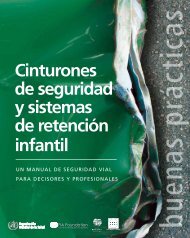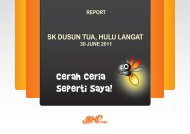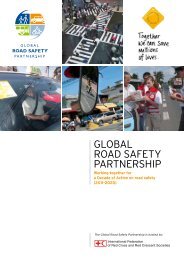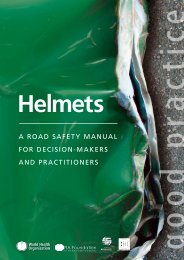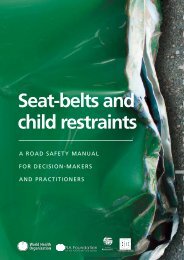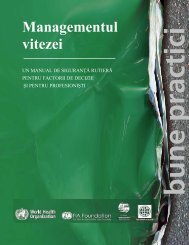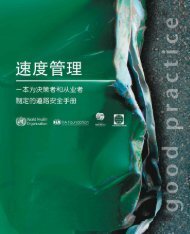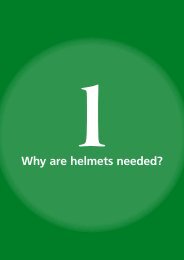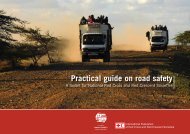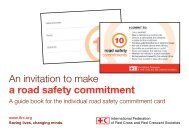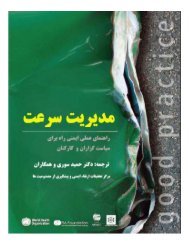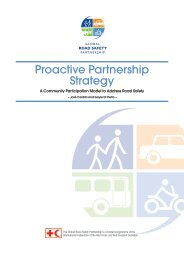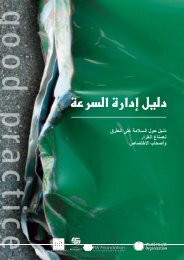How to design and implement a drinking and driving programme pdf ...
How to design and implement a drinking and driving programme pdf ...
How to design and implement a drinking and driving programme pdf ...
Create successful ePaper yourself
Turn your PDF publications into a flip-book with our unique Google optimized e-Paper software.
The primary consideration when setting up a checkpoint or roadblock is the safety<br />
of police officers, suspected drink-drivers <strong>and</strong> other road users. No site should be in<br />
operation without a <strong>design</strong>ated safety officer who has the responsibility of ensuring<br />
overall safety (this person may have other roles as well). Even where only two<br />
or three officers are operating, one officer should be the safety officer. Managing<br />
checkpoints includes:<br />
1. Choosing a safe location<br />
Drinking <strong>and</strong> Driving: a road safety manual<br />
Selecting a safe location includes considering:<br />
• locating the site where approaching drivers have sufficient time <strong>and</strong> visibility <strong>to</strong><br />
adjust their <strong>driving</strong> in order <strong>to</strong> safely negotiate the checkpoint. If in doubt, choose<br />
another location;<br />
• safety fac<strong>to</strong>rs for officers when setting up <strong>and</strong> dismantling the site. Persistent bad<br />
weather can render a site impractical or unsafe;<br />
• moving the site <strong>to</strong> a multiple locations during the course of the work period <strong>to</strong><br />
maximise the visible police presence;<br />
• sun glare for drivers approaching the site (the sun will change its position during<br />
the course of the day);<br />
• visibility for mo<strong>to</strong>rists, which is of particular concern at dusk <strong>and</strong> dawn, so extra<br />
precautions should be taken if the operation is taking place over that period;<br />
• locating night-time operations where there is effective illumination <strong>and</strong> providing<br />
additional lighting for high visibility;<br />
• control of vehicles moving in<strong>to</strong> the site as well as those vehicles passing it;<br />
• the avoidance of unnecessary traffic congestion. Judgement as <strong>to</strong> what constitutes<br />
unreasonable congestion is subjective, but as a general rule, if you cannot see the<br />
end of the traffic in the distance, it is time <strong>to</strong> suspend testing operations <strong>and</strong> allow<br />
it <strong>to</strong> flow until you can.<br />
• the use of natural barriers where traffic calming is achieved, e.g. <strong>to</strong>ll gates.<br />
3 | <strong>How</strong> <strong>to</strong> <strong>design</strong> <strong>and</strong> <strong>implement</strong> a <strong>drinking</strong> <strong>and</strong> <strong>driving</strong> <strong>programme</strong><br />
2. Slowing traffic safely<br />
On a two or three-lane carriageway, it is best <strong>to</strong> slow the traffic down using a funnel<br />
formation of delineation cones, a police checkpoint sign <strong>and</strong> a merge sign so that the<br />
selection <strong>and</strong> interception of vehicles can be done from a line of slow moving traffic<br />
rather than a high-speed one. A police car with flashing lights acts as a visible warning<br />
<strong>to</strong> approaching mo<strong>to</strong>rists <strong>and</strong> more importantly provides a safety corridor for<br />
officers <strong>to</strong> interview offending drivers. If the funnel method (see Figure 3.5) is chosen,<br />
be aware of the traffic volume both at the time of establishment <strong>and</strong> what could be<br />
expected later. Narrowing <strong>to</strong> one lane will au<strong>to</strong>matically create congestion so those<br />
not selected must be moved through quickly.<br />
This method may create advance notice that alcohol intervention enforcement is<br />
being undertaken. Suspected drink-drivers may take a number of evasive actions e.g.<br />
change positions with a passenger, ab<strong>and</strong>on their vehicle, attempt <strong>to</strong> drive through<br />
87



